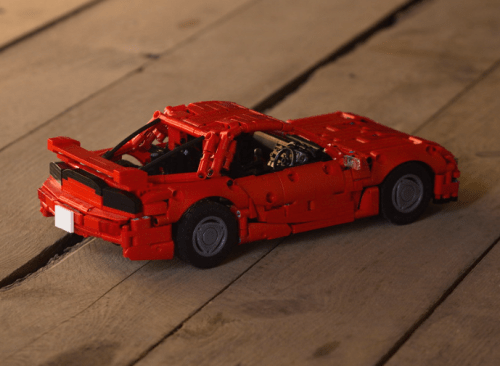
They’re the questions we receive here more than other (apart from your Mom calling to find out if we’re free); “Where can I buy this?” / “Are there instructions?”.
We’ve reviewed a range of books here at TLCB (see here, here, here and here) that aim to answer the questions above, providing parts lists and building instructions to enable readers to create real-world vehicles from LEGO bricks. Today we have another, kindly provided by publisher ‘Brick Monster‘ who have a range of both instructional books and downloadable building instructions available at their website, offering everything from BrickHeadz to dinosaurs.
Fast Bricks: Build 6 LEGO Sports Cars!
Overview: Brick Monster’s latest publication, entitled ‘Fast Bricks’, details the step-by-step building instructions and complete parts lists for six real-world sports and performance cars. Each car is designed to match LEGO’s old six-wide Speed Champions scale which, whilst less detailed than the new 8-wide standard, should mean both a plentiful parts supply and that fewer parts are needed.
The book follows the now familiar format that we’ve come to expect from instructional publications, offering a brief (and really well written) introduction to each car, along with a few key statistics – although in this case they are about the model itself rather than its real world equivalent.
Instructions and Print Quality: The bulk of the book is taken by the step-by-step instructions, which are clear and well laid out. Minor sub-assemblies are used every so often and all parts added are highlighted by a contrasting brightly-coloured outline, which is very nice touch. A ‘Bill of Materials’ ends each section, along with the alternate colour schemes available for each build. Unfortunately we have no images of these available to show here, which is something that Brick Monster should look into so that they can showcase this content.
‘Fast Bricks’ is not the glossiest book we’ve reviewed and nor is it printed in the highest quality, but it’s well suited to its purpose, where ultra high quality paper can actually be a hinderance to following building instructions, however beautiful the product looks. On the other hand one area where higher print quality would have been useful was in the instructions for C8 Corvette pictured on the cover, where the dark blue bricks chosen are hard to distinguish against the black lines that surround them. This is never an issue with official LEGO sets and highlights just how good LEGO are at both designing and mass-producing the building instructions found in their products.
The Models: It’s the Corvette that is probably the best model within the book, although all feature a range of excellent building techniques that newer builders may appreciate learning.
However, unfortunately for us in some cases the builds are not particularly recognisable as the car they are purported to be. We could have ten guesses for the Mazda MX-5 and Lamborghini Huracan and we wouldn’t have guessed correctly, with other models having only a passing resemblance to their real-world counterparts.
It’s a shame, because – whilst not really offering anything new – the layout, instruction designs, descriptions, and parts lists of ‘Fast Bricks’ are all pretty good.
Verdict: We wouldn’t have thought there was a need for yet another building instructions book, however the constant requests we receive here at The Lego Car Blog indicate that – as usual – we know nothing, and there remains a significant interest in step-by-step instructions for models.
We’re not sure that any book is the best medium for providing step-by-step instructions anymore, with digital downloads performing the job just as well, but nevertheless ‘Fast Bricks’ take on the book-based instructional formula is another competently engineered addition, utilising well-judged techniques and instructional designs to walk readers from a pile of LEGO bricks to a finished sports car model. We just wish the models found within it looked a bit more like the cars they’re supposedly based upon.
★★★
Like this:
Like Loading...





























